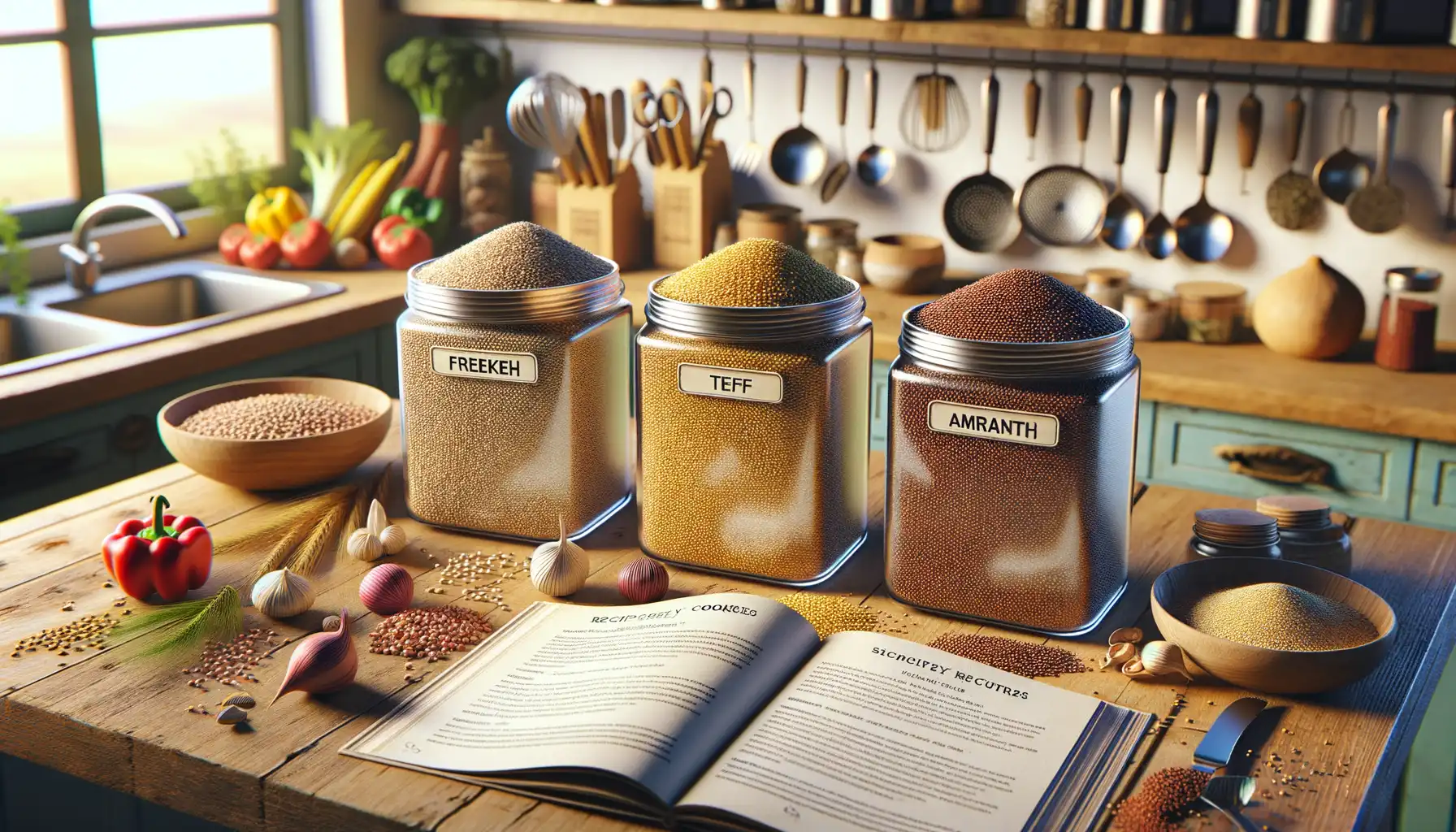The Nutritional Benefits of Ancient Grains
Why These Ancient Grains Deserve a Spot on Your Plate
Picture this: you’re eating something that has fueled civilizations for thousands of years — grains so rich in nutrients, they’ve stood the test of time. Ancient grains like freekeh, teff, and amaranth aren’t just trendy; they’re nutritional powerhouses waiting to transform your meals.
What makes them shine? For starters, many are naturally gluten-free (hello, teff and amaranth), making them a blessing for those with sensitive bellies. But there’s more:
- Freekeh: Packed with fiber that’ll keep you feeling full and energized, freekeh is also loaded with protein to power your day.
- Teff: This tiny Ethiopian grain boasts an impressive iron content, perfect for tackling sluggish afternoons.
- Amaranth: Call it the multitasker — it’s brimming with magnesium, calcium, and even lysine, an essential amino acid most grains lack.
A Treasure Trove of Antioxidants and Flavor
Here’s the kicker: these grains don’t just offer nutrition; they bring bold flavors to the table too. Freekeh has a smoky, nutty vibe; teff offers a subtle sweetness; and amaranth? Its earthy flavor transforms soups or breakfast into unforgettable moments. Bonus: they’re packed with antioxidants, helping your body fight off pesky free radicals.
Go ahead, sprinkle ancient magic on your modern life. Can you already taste the difference?
How to Cook with Freekeh, Teff, and Amaranth

Unlocking the Secrets of Freekeh
Cooking with freekeh is like discovering an ancient treasure buried in the sands of time—nutty, smoky, and brimming with flavor. To prepare this roasted green wheat, start by rinsing it under cold water. Then, cook it just like rice: a 2:1 ratio of water to freekeh works wonders. Bring it to a boil, reduce the heat, and let it simmer until the grains are tender, about 20 minutes.
Want a foolproof way to elevate your salads or grain bowls? Toss warm freekeh with roasted veggies, olive oil, and lemon juice. Craving comfort food? Use it in place of rice for your favorite risottos or pilafs. The chewy texture adds serious personality to every dish it touches.
The Tiny Powerhouses: Teff and Amaranth
These two might be small, but they pack a punch! Teff, an Ethiopian staple, is ideal for porridge or pancakes. Simmer it with almond milk and cinnamon for a creamy breakfast or use teff flour to whip up gluten-free baked goods.
Meanwhile, amaranth loves a good stovetop pop! Heat it in a dry pan and watch it transform into crunchy popcorn-like bits. For a hearty meal, try cooking amaranth into a polenta consistency—the nutty flavor pairs beautifully with sautéed greens and garlic.
Here’s how to experiment with each grain:
- Add cooked freekeh to stuffed peppers or as a side for grilled chicken.
- Mix teff or amaranth into soups to thicken them naturally while boosting nutrition.
Each grain holds centuries of tradition in its tiny kernels. Let them inspire your modern cuisine!
Incorporating Ancient Grains into Your Diet

Why Ancient Grains Deserve a Spot on Your Plate
When was the last time a meal truly surprised you? If your dinner routine has grown predictable, it’s time to shake things up with the wholesome magic of ancient grains. These aren’t your run-of-the-mill staples—they’re nutrient powerhouses with rich histories that whisper tales of faraway lands and ancestral feasts. Imagine swapping out plain rice for nutty, roasted freekeh, or infusing your morning routine with the earthy sweetness of teff porridge topped with fresh berries.
Start small—an ancient grain adventure doesn’t need to flip your pantry upside down. Here’s how:
- Mix cooked amaranth into soups for a velvety texture.
- Use teff flour in pancakes and quick breads—it adds a subtle depth of flavor.
- Create a hearty salad by tossing warm freekeh with roasted veggies and a drizzle of lemon tahini dressing.
Each bite will remind you: treating your body well doesn’t mean sacrificing taste or tradition. After all, these grains have stood the test of millennia—they’re more than ready to elevate your table!
Making Room for Freekeh, Teff, and Amaranth
Wondering where to start? Think of ancient grains as your culinary wild cards. They play well with just about anything. Feeling uninspired at breakfast? Swap oatmeal for creamy teff, cooked with cinnamon and coconut milk. For a quick lunch, fold nutty freekeh into your favorite veggie stir-fry—it soaks up sauces like a dream. And don’t forget snacks! Puffed amaranth sprinkled over yogurt or added to granola bars is delightfully crunchy.
Experimentation is key. Ancient grains can take a leading role in your dish or quietly enhance what’s already on your plate. Sprinkle, mix, roast, simmer—whichever way you choose, their bold flavors and endless versatility will have you hooked before you know it!
Popular Recipes Featuring Ancient Grains

Transform Your Table with Freekeh Magic
Freekeh is like the adventurous friend your pantry didn’t know it needed. It’s smoky, nutty, and just begging to be showcased in big, bold flavors. Looking for a salad that’s more exciting than iceberg lettuce? Toss together freekeh, roasted sweet potatoes, baby spinach, and a lemon-tahini dressing for a vibrant burst of flavor. Or, cozy up on a cold evening with a hearty freekeh and vegetable soup—it’s rib-sticking comfort without the carb coma. For something truly wow-worthy, use freekeh as a base for stuffed bell peppers. Imagine those grains soaking up garlicky tomato sauce… *chef’s kiss*.
Baking and Beyond: Teff and Amaranth in Action
Let’s talk about baking with ancient grains—it’s an adventure, not a science project! Have you tried using teff flour in a warm, indulgent chocolate brownie recipe? Its slightly malty flavor adds a depth you didn’t know you were missing. Or maybe start your morning right with amaranth porridge. Top it with fresh berries, a drizzle of honey, and toasted almonds for a breakfast that feels decadent but fuels your day like a pro.
Feeling brave? Experiment with this powerhouse duo in savory dishes too:
- Use teff as a crispy coating for pan-fried chicken or fish.
- Simmer amaranth into a creamy polenta alternative topped with sautéed mushrooms.
Ancient grains are like the secret ingredient you’ve been searching for—their versatility, flavor, and texture add excitement to every plate. 🥄✨
Tips for Storing and Buying Ancient Grains

Smart Strategies for Storing Your Ancient Grains
Ancient grains are tiny powerhouses, but they need a little TLC to stay fresh. Think of them as fine wine—storage matters! The golden rule? Keep them cool, dark, and dry. Pantry space limited? Pop your bags of freekeh, teff, or amaranth into airtight containers or resealable jars (glass works wonders!) to lock out moisture and pesky pantry insects.
If you live somewhere humid or plan to store them long-term, consider the freezer. Yup, frozen grains aren’t crazy—they’re genius. They’ll retain their nutty flavors and vibrant nutritional profile for months! Oh, and don’t forget to label your jars with purchase dates. Trust me, it’s a lifesaver when you can’t remember if that teff was from last week or last year.
The Art of Choosing Perfect Ancient Grains
Picking the right grains feels like being at a farmer’s market, choosing the juiciest peach. Start with these tips:
- Look for grains with a natural, earthy color—nothing dull or faded.
- Avoid packages with signs of moisture or tears (a surefire way to invite freshness-zapping air inside).
- If buying in bulk, take a good sniff! Quality freekeh should smell smoky and nutty, while teff and amaranth often have a faintly sweet aroma.
Local co-ops and health food stores often carry the freshest options, but don’t shy away from reputable online retailers if your local selection is limited. Pro tip? Opt for organic whenever possible—it’s kinder to the planet and usually richer in flavor.